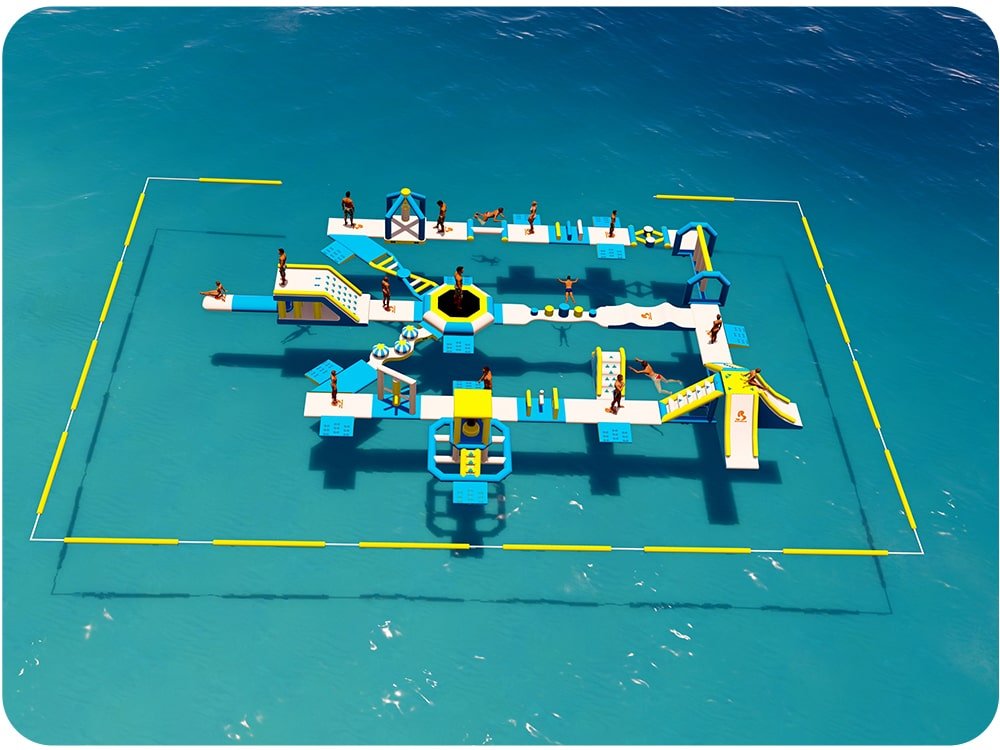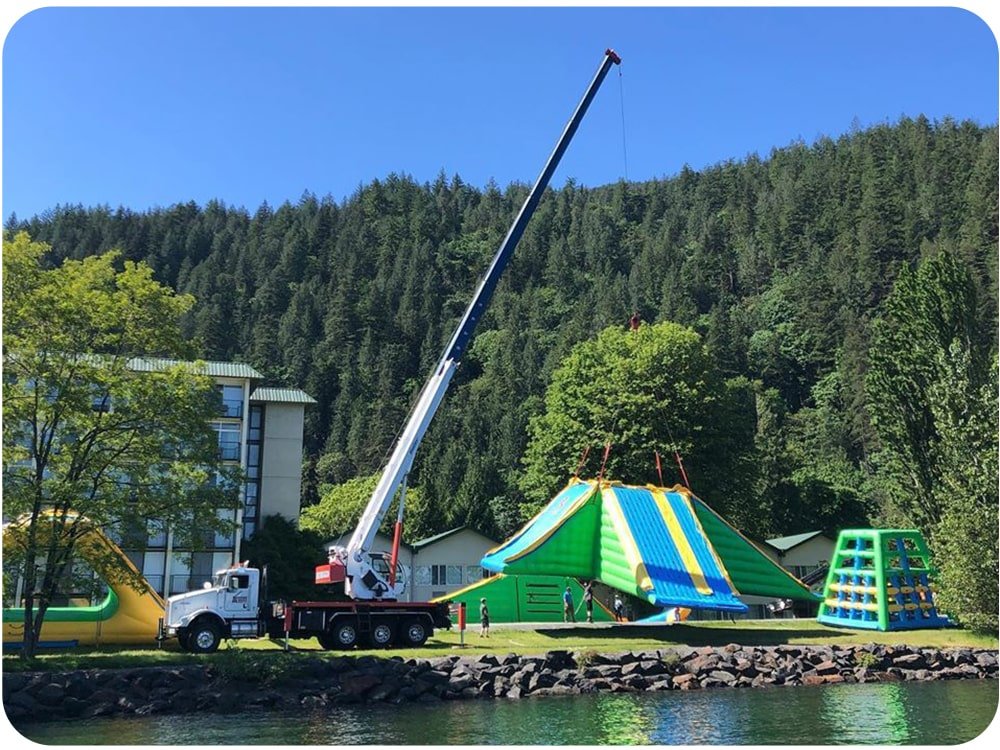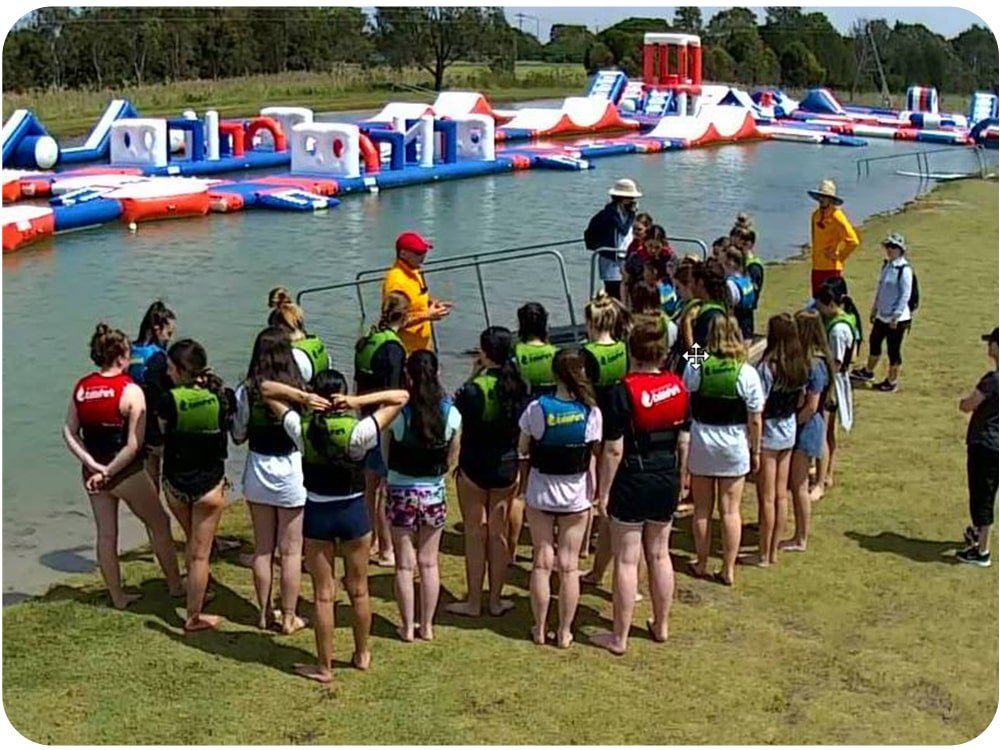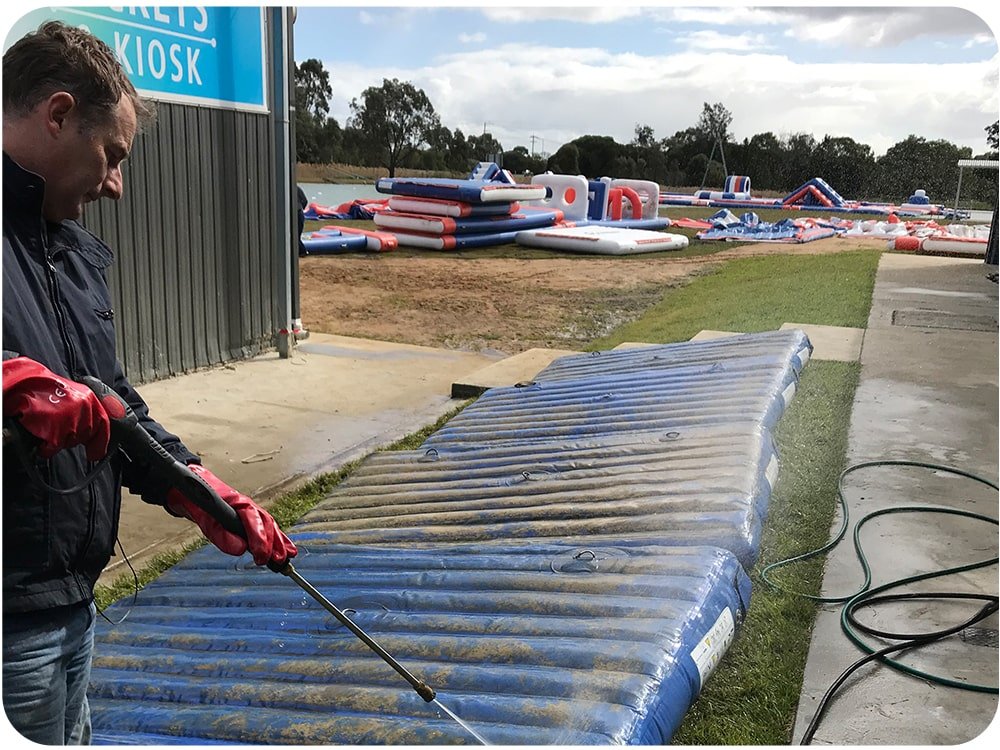Floating water parks are loved all over the world, especially in places like Australia, the UK, France, Latvia, and across Europe. They turn ordinary summer days into fun-filled adventures for everyone, from families to those who love a bit of excitement. If you’re thinking about starting a business in this popular industry, this guide offers you clear steps to set up your very own floating water park.
When choosing a place for your floating water park, it’s important to find a spot that’s beautiful and works well for water fun. You need a place with plenty of clean water and enough room for all the different inflatable rides and games. The water should be deep enough so that the big slides and towers are safe for everyone to use. 2.5-5m deep is a good depth. Also, make sure you can use this place for many years. A long-term agreement for using the land and water helps your business grow without the worry of moving. This means you can focus on making the park better and more fun for your visitors without having to think about finding a new place to set up.


Gaining a deep insight into who your water park will cater to is essential. Consider whether your main visitors will be local families looking for a day out, teenagers seeking excitement, or tourists exploring the area. Reflect on the average amount of money these groups might be willing to spend at your park. It’s also important to look at your competitors: what they offer, their pricing, and how they’re perceived by customers. Thoroughly understanding these aspects will help you tailor your marketing efforts more effectively, set competitive prices, and design services that meet the specific needs and expectations of your visitors. This comprehensive audience analysis is a cornerstone for the successful planning and operation of your floating water park.
Your business plan serves as a detailed blueprint that captures the essence of your market analysis. It should clearly articulate the park’s vision and mission, painting a picture of the desired impact and the guiding principles behind your venture. Delve into the financial side, projecting your earnings and expenses to forecast profitability over time. This plan should also include a risk management strategy, highlighting the potential obstacles you might face and laying out a proactive approach for addressing these issues. From safety concerns to market fluctuations, your plan should provide robust solutions and contingency plans, ensuring your floating water park is well-equipped to navigate the unpredictable tides of business.


Determine the financial requirements for your floating water park by consulting your business plan. Explore various funding options, like bank loans, seeking investors, or launching a crowdfunding campaign. For each option, assess the potential funding amount, the expected time to obtain the funds, and any financial commitments or repayment schedules involved. It’s vital to fully understand the conditions, such as interest or profit-sharing, and how they might influence your business’s future operations and control. Careful consideration of these financing sources will lay a solid foundation for your park’s launch and growth.
Collaborate closely with skilled designers to craft a layout for your floating water park that prioritizes safety while delivering an immersive experience. Consider the journey your visitors will take; from the moment they enter until they leave. Strategically place a diverse array of attractions to provide an enjoyable experience for all ages and thrill levels. Each element should seamlessly integrate into the park’s overarching theme, creating a cohesive and memorable environment. Also, ensure the design allows for smooth crowd movement, minimizing bottlenecks and maximizing guest satisfaction. This careful planning in the design phase is crucial to operating a successful water park.



Dealing with the legal requirements of setting up a floating water park is intricate yet vital. Begin by obtaining every permit required by local and regional authorities to ensure your park operates within legal boundaries. This process may include zoning permits, health and safety approvals, and environmental assessments. Additionally, securing comprehensive public liability insurance is non-negotiable. It safeguards your business from claims related to injuries or accidents that might occur on your premises. This insurance coverage is not just a safety net for your visitors, but it’s also a shield for your investment, covering unforeseen incidents that could otherwise risk the financial stability of your park. Understanding the specifics of these legal and insurance aspects is foundational for establishing a trustworthy and responsible business.
For the efficient handling of your floating water park’s finances, initiate a business bank account tailored to manage both local and international transactions. This account is crucial for consolidating payments from customers buying tickets and for settling accounts with suppliers. Opt for a bank that provides a seamless service for handling multiple currencies, which can be a great advantage when dealing with foreign transactions and can protect against fluctuating exchange rates. This will not only streamline your revenue collection but also simplify the payment process, ensuring you can swiftly manage the financial aspects of your water park operations.


When it comes to equipping your floating water park, prioritizing durability and quality ensures long-term satisfaction and safety. Selecting the right supplier is critical; you need a partner that not only sells equipment but also guides you to make the best choices for your specific needs. This means looking for suppliers with a reputation for excellence, like Bouncia, who not only provide equipment but also bring a wealth of experience and advice to ensure you receive products that are worth the investment. High-quality, resilient equipment minimizes maintenance issues and replacement costs, providing a better return on investment and a safer experience for your guests.
Assembling a dedicated team is essential for your floating water park’s success. Focus on recruiting individuals who are enthusiastic about delivering a blend of safety and entertainment. You’ll need a diverse range of skills, covering everything from day-to-day operations to emergency safety procedures, guest relations, and promotional activities. Look for candidates who are not only qualified but also align with your park’s core values and commitment to providing memorable experiences. This team will be the driving force behind your park, so invest in training and development to ensure they’re equipped to meet the highest standards of service and safety.


The effectiveness of your floating water park heavily relies on a well-trained staff. Devote resources to develop an extensive training program that encompasses not just the operational aspects of each ride and attraction but also emphasizes the importance of safety protocols, emergency response, and first aid. Beyond the technical skills, training should also instill excellent customer service principles, ensuring every team member can engage positively with visitors and enhance their overall experience. Equipping your team with this knowledge and skillset is fundamental in fostering a culture of safety, efficiency, and hospitality that defines the reputation of your water park.
For your floating water park to thrive, a dynamic marketing strategy is essential. Craft targeted campaigns that harness the power of social media to create excitement and anticipation. Collaborate with local businesses and influencers to widen your reach and establish a community presence. Plan engaging opening day events that promise unforgettable experiences, incentivizing first-time visitors to become regular guests. Additionally, explore various advertising mediums, both online and offline, to build a strong brand identity. A comprehensive approach to marketing will help you capture the interest of potential customers and keep them coming back for more aquatic adventures.


Selecting the most appropriate anchoring system is critical for ensuring the safety of your guests and the durability of your floating water park structures. The anchoring method must be strong enough to withstand not just the forces of nature but also the energy of active visitors. Concrete block anchors are often recommended by experts like Bouncia because they provide a steadfast solution that can endure the rigors of a busy park. These anchors maintain the position of the equipment, resist shifting and are less prone to wear from constant movement. By investing in a high-quality anchoring system, you protect your assets and provide a secure environment for fun-seekers.
Planning for the installation of your floating water park should include a generous timeline and a backup plan in case of inclement weather. Engage with professional installers who are experienced in assembling floating structures to ensure that every piece is set up correctly, firmly anchored, and tested for stability. This careful attention to the installation process not only secures the safety of your attractions but also enhances the overall efficiency of your operation. Proper installation is a critical step that impacts the smooth running of your park and is a precaution that will contribute significantly to the safety and satisfaction of your patrons.

Implementing a phase of operational testing is key to ensuring your floating water park runs smoothly. Prior to your official opening, organize a series of controlled soft launches to test all aspects of park operations. These trial runs not only help in refining the visitor experience but also provide an opportunity to train staff in a real-world setting. Invite a limited audience to use the park and provide feedback on their experience, which can be invaluable in making final adjustments. This proactive step will help identify and rectify potential issues, ensuring that when the grand opening day arrives, your park operates seamlessly, providing guests with the safe and enjoyable experience they expect.

Focus on the customer journey from start to finish. Use feedback and surveys to continually improve the customer experience. Consider implementing technology like virtual queue systems to enhance visitor satisfaction.
Optimizing the guest experience is essential for the success of your floating water park. Pay attention to every detail of the customer’s journey, from the moment they consider visiting to the end of their day at your park. Implement tools like customer feedback forms and satisfaction surveys to capture their insights and preferences. Regularly analyze this feedback to make informed improvements in all areas, including attractions, services, and facilities. Additionally, embrace modern solutions such as digital queue management to reduce wait times and distribute guests evenly throughout the park. Integrating these technologies can significantly boost the overall enjoyment and convenience for your visitors, encouraging repeat business and positive word-of-mouth.
Maintaining rigorous health and safety standards is non-negotiable for a floating water park. It is imperative to adhere to all regulatory safety guidelines and best practices to safeguard both guests and staff. Conduct frequent and thorough training sessions for your team, focusing on emergency response, lifesaving techniques, and efficient evacuation procedures. Ensure that first-aid stations are accessible throughout the park, fully equipped, and staffed by trained medical personnel. By establishing a culture of safety that permeates every aspect of your operations, you provide a secure environment where fun and well-being go hand-in-hand, instilling confidence in your visitors and setting a benchmark for industry excellence.



Maintaining your floating water park is crucial to ensure longevity and safety. Here’s how you can keep your attractions in top condition:
For parks in saline water environments, barnacle growth on the undersides of products is common. Schedule divers approximately once a month to gently remove any build-up with non-sharp tools.
To optimize your floating water park’s revenue, implement flexible pricing models that reflect real-time demand, peak periods, and any scheduled special events. Analyze visitor traffic patterns to adjust ticket prices dynamically, perhaps offering discounts during off-peak hours to attract more guests, and premium pricing during high-demand times to maximize earnings. Also, consider special pricing for events, holidays, or exclusive access periods, which can create urgency and increase sales. A well-thought-out dynamic pricing strategy not only boosts profitability but also can help regulate park attendance, ensuring a quality experience for every visitor.
Creating clear and effective communication systems is essential for the smooth operation of your floating water park. For staff coordination, equip your team with reliable communication tools like radios, which facilitate instant and discrete conversations, crucial in managing day-to-day operations and responding to emergencies. For visitors, install a robust public announcement system to broadcast important messages and safety information. Complement this with well-placed, easy-to-read signage across the park, guiding guests and providing instructions for a seamless experience. These communication measures are key to maintaining order, ensuring safety, and providing a positive park experience for all guests.
To maintain the appeal and excitement of your floating water park, it’s crucial to periodically refresh your offerings with innovative attractions. Stay attuned to emerging trends in the water park industry and actively solicit feedback from your visitors to understand their evolving interests. Use this information to guide the introduction of new, thrilling experiences and enhancements to existing ones. This proactive approach in updating and innovating ensures that your park remains a must-visit destination, encouraging repeat visits and attracting new guests looking for the latest in aquatic adventure.


Achieving operational excellence is fundamental to the success of your floating water park. This involves meticulously planning the layout to facilitate smooth visitor movement and reduce congestion, particularly in high-traffic areas. Enhance the customer experience by offering a variety of high-quality food and beverage options that cater to different tastes and dietary needs. Maintain impeccable cleanliness and ensure easy access to restrooms and other amenities. Regular audits of operations can help identify any inefficiencies or areas for improvement. By excelling in these operational facets, you elevate the guest experience, which can lead to increased patronage and positive reviews.
Developing a trusted brand that resonates with visitors encourages repeat visits and fosters brand loyalty. Establish reward programs that incentivize frequent visits through discounts or exclusive benefits. Introduce season passes for guests who wish to enjoy unlimited access, enhancing the value proposition. Additionally, create a line of branded merchandise that not only serves as souvenirs but also as a means for guests to carry the memory of their experiences with them. These initiatives, coupled with consistent quality service, turn first-time visitors into lifelong patrons and brand ambassadors for your floating water park.
By following this extended guide and focusing on comprehensive planning, customer experience, and continuous improvement, you’re setting your inflatable floating water park up for success. Remember, Bouncia is here to support you every step of the way with expert advice and top-quality floating water park equipment. Reach out to us to begin crafting your dream water park today.
If you want to learn more about us or our products, welcome to leave a message below.
Copyright 2025 – Website by Guangzhou Bouncia Inflatables Limited. All Rights Reserved.